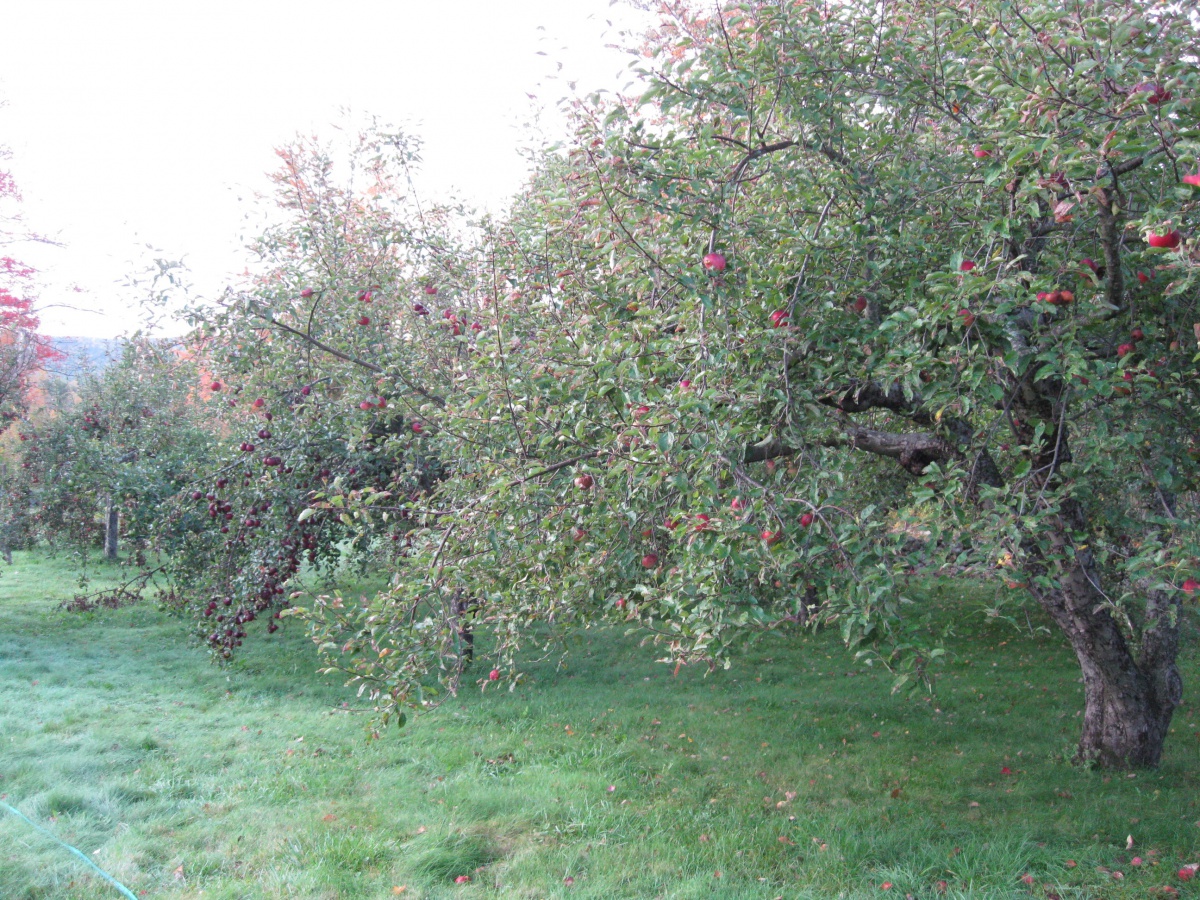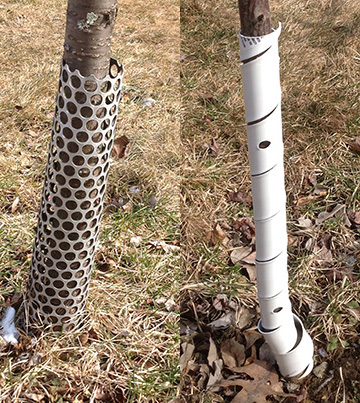Introduction
Backyard apple trees can be valued additions to the home garden, offering fresh, flavorful and healthful fruit, summer shade and the beauty and aroma of spring blossoms. To get these results, home growers must pay careful attention to pruning, pest management, tree nutrition and other cultural practices.
Pruning
No single cultural technique is more challenging to many home gardeners than pruning. The key to pruning is to understand the basic principles of pruning and adapt them to each tree.
Pruning reduces tree size. Although pruning stimulates shoot growth, especially near the sites where pruning cuts are made; the overall effect is to reduce total tree size. Leaves are the food-manufacturing organs of the tree and eliminating a portion of them (by removing the vegetative buds that will grow come spring) will reduce the total amount of growth the tree makes.
Pruning effects are localized. Strong shoots with large leaves tend to arise at or near the site of pruning cuts.
Pruning does not alter the natural habit of the tree. Certain varieties such as Red Delicious and Macoun have a very upright growth habit that cannot be changed to a more spreading habit by pruning.
Excessive pruning has adverse effects. Severe pruning upsets the tree’s balance. It will result in over-stimulating the growth of water sprouts (suckers), cause a loss of fruit color and delay fruit maturity. It is usually best to prune lightly to moderately every year.
Make clean cuts at the outer edge of the branch collars. Pruning wounds on healthy trees usually heal over in 1 to 2 years as the result of the tree’s natural healing process. Eventually, living tissue (normal bark and sapwood) will completely cover the wound. Rapid wound healing reduces the chance of invasion by rot-causing organisms. Clean cuts made at the outer edge of the collar that forms
where the branch joins the parent limb will minimize healing time.
Narrow-angled crotches are weak. Narrow crotches are weak due to the inclusion of bark between them as the limbs grow. Branches with narrow crotch angles will often “split out” when they become heavy with fruit or snow and ice loads. In addition, the tissues in narrow crotches harden slowly in the fall and may be more susceptible to winter injury, rot organisms and cankers.
Late, dormant season pruning is best. The ideal time to prune apple trees is between February and April. Avoid fall or early winter pruning, which increases the risk of severe winter injury to the trees.
Wound dressings. Pruning wounds require no special treatment if the cuts were made at the outer edge of the branch collar.
Pruning Bearing Apple Trees
Applying these basic pruning principles to your mature (bearing) backyard apple tree is the next step. The following guidelines may make the job easier.
1. First, remove all broken, dead or diseased branches.
2. If trees are too tall for spraying and harvesting, reduce the height by cutting the main upright growing branches back to a well-developed horizontal lateral.
3. Remove all water sprouts (fast-growing, upright branches) and branches that cross and rub other branches.
4. Prune to leave branches that are nearly, but not quite flat, eliminating those that hang down or grow upright.
5. Eliminate branches that make narrow crotch angles to eliminate splitting or breaking under crop load stress.
6. Prune more heavily in the upper part of the tree than the lower. Reducing the spread of the upper limbs will allow more sunlight to reach the lower limbs and help remain fruitful.
7. When reducing branch length, make thinning rather than heading cuts. Thinning cuts (removing branches completely) reduce competition between limbs for space and light, enabling better light and spray penetration. Heading cuts (cutting back a branch to just above a bud or side branch) often stimulate vigorous unrestricted growth immediately below the pruning cut.
8. Prune moderately each year and do not remove a branch unless there is a good reason for doing so.

This cut was made just outside
the “collar” present where the branch
joined the parent limb. A face view (below)
shows how this wound will heal over time.
Photo: William Lord

A pruning wound fully healed
just 2 years after proper cut was made.
Photo: W. Lord
Bringing Back Large, Old, Abandoned Apple Trees
The same basic rules are followed as with younger, bearing apple trees.
1. Dead, diseased, and broken limbs are removed first. For old, neglected trees, this might be all the pruning cuts you make in the first year.
2. Water sprouts (shoots growing straight up off lateral branches) are removed next.
3. Whole branches are removed to allow light penetration into the canopy of the tree, focusing most of the branch removal activity in the upper half of the tree canopy.
4. Suckers that grow during the summer following this pruning should be removed about August 1st.
Fertilizing Backyard Apple Trees
First, get a soil test. Soil pH should be adjusted to a pH of 6.2-6.5, following soil test recommendations.
Bearing apple trees should be fertilized based on how much growth they made the previous season. If trees are weak (less than 8 inches of new growth the previous year), apply 1 lb of a general purpose fertilizer such as 10-10-10 in early May. If trees are growing more than 8 inches annually, no nitrogen is usually needed. For these trees, apply 1 lb sulfate of potash (0-0-50) or 2 lbs of sulfate of potash-magnesium (0-0-22) for every 5 bushels of apples harvested per tree. Apply in early spring after growth begins. Broadcast it evenly on the soil surface under the entire canopy of the tree.
Apple trees will also likely need boron on an irregular basis. If trees are deficient in boron, brown, corky areas about the size of pencil erasers will form in the flesh of the fruit. To prevent boron deficiency in these large trees, water well during dry periods, especially if soil is droughty, and apply borax (available at garden centers and in the laundry section of supermarkets) at the rate of 1 cup borax every 3-4 years. Again, spread evenly on the surface of the ground under the tree in early spring.
In many cases, backyard apple trees are in a lawn that is fertilized. Reduce the amount of fertilizer applied under the tree to prevent over-fertilization. Never use fertilizer-weed control combination products or lawn weed killers alone around fruit trees as these products can cause injury.

Brown corky areas in flesh are
caused by low boron. Photo: W. Lord
Insect and Disease Control
Unfortunately, several insect and disease pests attack apples in New Hampshire. If left uncontrolled, these pests will destroy the apple crop completely in many years. Adequate control of these pests will require using certain EPA-approved pesticides in a properly-timed spray program. For more information about pest management, please see the Home Fruit Spray Schedule.
Orchard mice (voles) may cause severe damage to apple trees. Most of the injury (girdling) occurs under the cover of snow when food is scarce. Girdling by voles can be prevented by using wire vole guards.
Use ½ inch or finer mesh hardware cloth to construct wire cylinders that are placed around the tree trunk. The mouse guards should be 18 inches high so they will be above the snow level and should be imbedded into the soil 1 inch.
Plastic wrap-around mouse guards are also available and will provide adequate protection. Remove plastic guards each spring and reapply each fall. This will eliminate the possibility the wraps will stretch, leaving exposed wood that voles will eat. It also eliminates dark, moist conditions near the trunk during the growing season. These conditions favor certain insect and disease pests and may prevent the trunk from hardening off properly, increasing its susceptibility to winter injury.
Other measures can help reduce vole populations near trees. Keep the orchard floor mowed to eliminate the cover of tall grass. Remove all fruit drops from the orchard floor immediately after harvest as these will draw voles into the tree area.


guards are shown above, or you can makeyour own from mesh hardware cloth. The
wrap-around plastic guards are not recommended because they provide shelter
for borers and can spread apart, leavingaccess for voles to feed and girdle trees.
Thinning the Crop
It is desirable in many years to reduce the crop load that results from a heavy bloom and a good “set.” Allowing too many fruits to remain on trees will reduce fruit size and tree vigor and can cause the tree to bear biennially (every other year). Thin apples to single fruits when they occur as doubles or triples. Use additional thinning to produce a final fruit spacing of 6 to 8 inches between fruits. Fruit thinning is not necessary every year and often is needed only on certain branches within a tree. Thin after the natural June drop but before July 1st.
Download the resource for the complete fact sheet.
